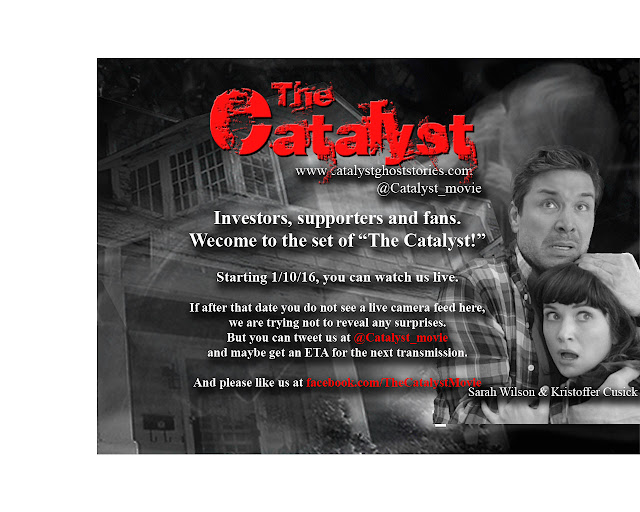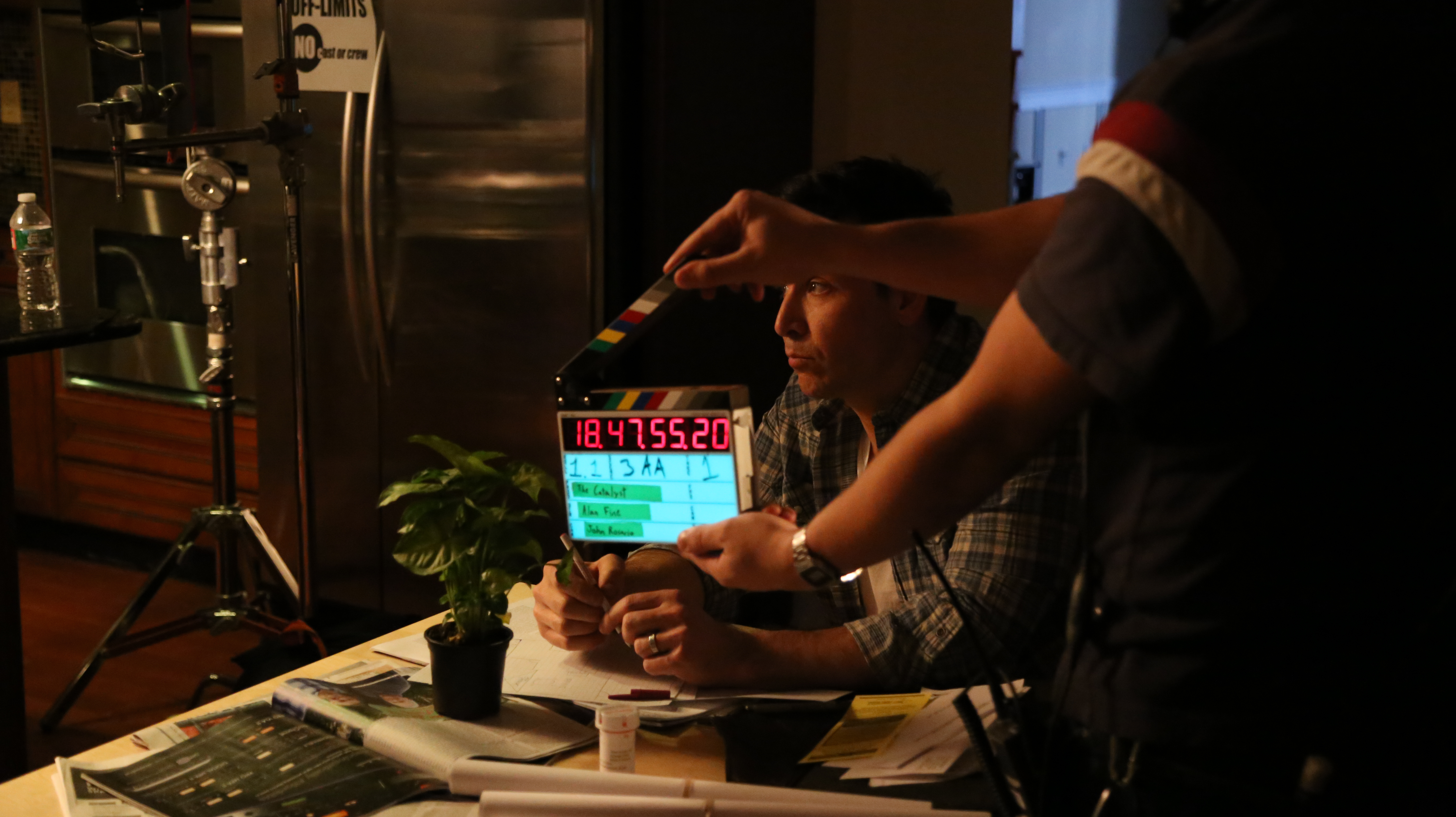Monday, January 18, 2016
Dear “Catalyst” Diary… Vol. 11
LIVE FROM THE SET!
I was hoping it would be a great stepping stone — and good training — to make an all-out feature film-style short before trying to actually go the distance on a feature. I was right. This experience has given me the confidence to proceed to the next level. It has also left me exhausted, but excited about the next phase of post production. (I am about to begin editing. Once the picture is locked, sound, visual effects and music will be next.)
I am now even more respectful of the production process. The number of details that go into making a movie are mind boggling. As a writer, it is so easy for me to type, “Rob gets up and looks all over for a pitcher.” But then you have to cast Rob, you have to “cast” the type of pitcher, the type of room, the camera to capture it, the lights to show it, and they all have to arrive at the same time and at the same place, and all transactions must comply with the applicable laws and Union rules. Suffice it to say, from when I wrote that sentence, to when I called, “Action,” a lot had to happen.
Richard D’Angelo
I was — and still am — being shielded from much of it by my detail-oriented and well-connected producer, Richard D’Angelo, who handled every facet of production. A teacher at the New York Film Academy, he also trained my tireless Production Manager Francesca Morello and Associate Producer Jolene Mendes, and handpicked everyone else in the crew. Also looking out for me was my personal friend and Production Supervisor, David Herman and Casting Director Donna McKenna who found our great cast and will receive a Producer credit for working within our budget and introducing me to Richard D’Angelo.
So these were the people who handled the iceberg, but I can report on the tip of it…
Just days before we were to shoot, the budget was climbing. Our location was a 4 bedroom / 3.5 bathroom home in Fort Lee, NJ. It was listed on Airbnb for $199 a night. Once they heard we will filming, it shot up to $500 a night. Gulp. In order to know what movie lights to order, we needed to visit the location, but we couldn’t… it was rented. As a precaution, our Director of Photography, the visionary John Rosario, requested extra lighting equipment, about $1500 worth. I made the mistake of getting involved.

My good friend Gail Savarese at Paramount on Location said she could help us receive a grant for a camera from Panavision. My thought was to get a free camera and apply the $1500 camera rental toward the needed lights. This was just days before shooting. Usually it takes weeks to apply for a grant, but sure enough, Gail came through. Within 24 hours, we were given one of the best cameras there is, the Red Dragon complete with Panavision’s exquisite lenses. (To put this camera package in perspective, you can shoot in SD or Standard Definition, or HD which is High Definition, or 2K or 4K. Most films today are shot at 4K. The Red Dragon allowed us to shoot 6K. That means for our little film has enough visual definition to project in an IMAX theater without compromise.) But back to the point… the budget was climbing and I thought a free camera would allow us to move money around. I was wrong. That free camera was worth almost a half million dollars and the insurance was close to $3000, so that free camera put is deeper in the hole.

“That’s a wrap!” 4:15AM 1/13/16
We descended on Fort Lee, New Jersey for five days. The first is called a “scout” day. This is when the Production Department figures out where the equipment will be stored, where the food will be served, where hair/makeup/wardrobe will be, which bathroom will be for crew vs. talent, which rooms will be dressing rooms by day and where John and I (and any of the other principals) will crash each night. (And I mean CRASH. In order to better control the light, we shot from 5:30pm to 4:30am.)

Haunted Bathroom…
I didn’t sleep well the first night. I left the bathroom light on. Twice I opened my eyes and saw the light was off. At first I thought it blew out. Then I thought it was on a timer, but that made no sense, especially since it came back on again a few moments later. The moment it went off again, I ran into that room, making a mental note of how nervous I was. I discovered the switch had not moved “on its own.” It was in the same position, meaning there must have been a short in the wire somewhere. Still, it was fun to imagine a scene from the feature film script had come true; a ghost learns to be a poltergeist and flip a light switch.
John Rosario and Alan Fine
The second day is called “pre-light.” Although John and I started early the day before, this was the day we concentrated in earnest on actor and camera blocking (choreography around the set.) Based on that, John would know how best to set the lights.
You know when you watch a conversation in a movie, how the camera goes from one person to the other, and back again? Well, if you shot each half of the conversation, stopped, moved the lights, shot some more of the conversation, stopped and moved the lights again, you would spend most of your time moving lights. So to prevent that, our first AD or Assistant Director, Attapol “EQ” Worrawuttaweekul’s flexed his extraordinary organizational skills and organized the shots John and I were designing in the order that would conserve the most time. His job was also to predict how long each shot should take so we would know whether we were on schedule as we progressed.

Day one of the shoot, we slowly slipped behind about 90 minutes. But it was day one. I wanted a relaxed set and we thought we would make the time up on day two. The first day was to be dialogue coverage of our two leads, Sarah Wilson and Kristoffer Cusick. Master shots, over the shoulder medium shots and close ups.The actors were wonderful. I called them “one take wonders,” but we took two and three takes just to be sure. John made each shot look moody and gorgeous. My ultimate goal had been realized; the individual shots at least looked like a studio picture. Thank you, John!
Day two was meant for finishing dialog from the day before and then starting and completing special effects. Time was ticking and it wasn’t until mid-day (after lunch break or just before midnight) that we started dragging to a corner our lead actress as if a ghost had her by the mouth.
That wasn’t as scary as the few times I left the comfort of John Rosario or Richard D’Angelo’s guidance, and made a decision on my own. At 3am on day two, with only 90 minutes left before crippling overtime costs would set in, I requested we stop shooting dialog coverage and make sure we get two very important effects shots. After all, both our Special Digital Effects Supervisor Lucien Harriot of Mechanism Digital and Waldo Warsaw our Practical Effects Supervisor had been on hand the entire 12 hours and would not be available on day three.
At 4:26am, the entire crew held their breath and watched as — one by one — objects in the room were pulled from shelves by filament wires you couldn’t see (or would be removed digitally). It was a real hand-holding “Kumbaya” moment for us, and as rewarding for me as anything I ever experienced playing team sports. I look forward to more like that.
Emma Gladstein and Alan Fine
Similarly, on the third day, shooting scenes with cute-as-a-bug Emma Gladstein and keeping the quality took its toll. With but two hours left to the shoot, we switched gears, hid all the movie lights, swapped all the practical (actual) light bulbs with red ones and filled the house with fog. Then we mounted a single cold light on the camera and ran it through the house, capturing everything we shot previously, but from the point of view of our ghost. We finished about ten minutes before our time ran out, cracked the champagne and beer and took the photo of the crew above labeled, “That’s a wrap!.” (Kris was showering to leave immediately for the west coast, so to include him and make the picture complete, we “photoshopped him in” using the only picture we had of him straight on. Sorry, Kris. 🙂 ) Below is a better one.
Kristoffer Cusick
Presently, the Production Office is dealing with the aftermath. Returning equipment. Paying people. Balancing books. I’m focusing on this newsletter and then the edit.
Sarah Wilson and Kristoffer Cusick
As many of you know, in a former life I was a technical consultant for DreamWorks and Paramount Pictures. I’m hiring myself for this project, because now everything in post production is computer-based and technical. I’m beefing up my system to handle the massive 6K files we shot and reading what I can to make sure I’m ready.
Kristoffer Cusick, Alan Fine and Sarah Wilson
In summary, I learned my two favorite parts of creating a movie are writing and editing; the former uses words and the latter uses pictures to tell a story. Directing is a necessary evil if you want to make sure the pictures captured reflect what was written and what will be edited.
Alan Fine
In the next newsletter (after I make some headway on the edit), I’ll cover things I forgot during the shoot, and begin to discuss post production and what IT is like.
Makeup applied to Sarah Wilson’s lips to make them appear cracked from a ghost attack.
I still can’t thank everyone enough, but I’ll keep trying.
Thank you everyone!
If you would like to be emailed these Catalyst Filmmaker Blogs rather than remember to visit our site, please click here…
Alan Fine
alan@catalystghoststories.com
CatalystGhostStories.com
@Catalyst_Movie


Recent Comments